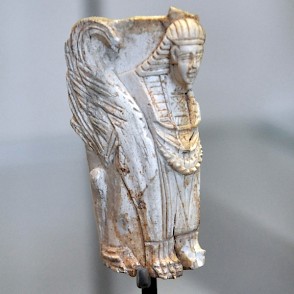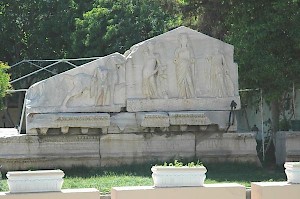Oea (Tripoli)
Q1994812Oea (Punic W'jt): Roman city in Libya, modern Tripoli.
History

Oea was a Phoenician town along the coast of what is now called Libya. Together with Lepcis Magna and Sabratha, Oea was reckoned to be part of the Tripolitana; as a matter of fact, it was the main city and when, in Late Antiquity, the other towns were evacuated, Oea was simply called Tripoli, "the three cities". Of the earliest days, a couple of Phoenician monuments remain. A tophet proves that the mlk-sacrifice was performed.
There are indications that the town, although founded by Phoenicians, was expanded by settlers from Sicily and especially Carthage, to which Oea, like the other Tripolitan towns, paid tribute. It was captured in 162 or 161 BCE by the Numidian ruler Massinissa, and became Roman during the war against Jughurta. However, it remained nominally independent, although this independence was soon an almost empty name.

Oea/Tripoli was attacked by Arab armies in 642, but withstood the siege for one month, and although Arab sources claim that the city was finally captured, it seems to have returned to the Byzantine Empire soon, and would accept Arab sovereignty only later.
Monuments
Because modern Tripoli is built on top of ancient Oea, there are not many visible ruins. The only monument that is still visible, is the-socalled the Arch of Marcus Aurelius. Several mosaics have been brought to the National Museum. A mithraeum has been identified, which appears to date to the fourth century and must have been built by men who refused to become Christians.

Oea also boasted a small temple dedicated in 183/184 to the Genius of the Colonia by a man named Lucius Aemilius Frontinus. On the pediment (the triangle-shaped upper part of the façade), one could see one of the Divine Twins, Apollo, Tyche (good fortune), and Minerva. The other twin is missing. Apollo and Minerva were the protectors of Oea. The name of the emperor Commodus has been erased from the inscription (damnatio memoriae).
Of course, there must have been more in Roman Oea than an arch and a small temple, a mithraeum, and houses with mosaics. It must have been a lively town with all kinds of craftsmen and merchants. Ten kilometers west of Tripoli, you will find the very interesting rock tomb of Janzur, which is just one example of what must have been Oea's much larger western necropolis.